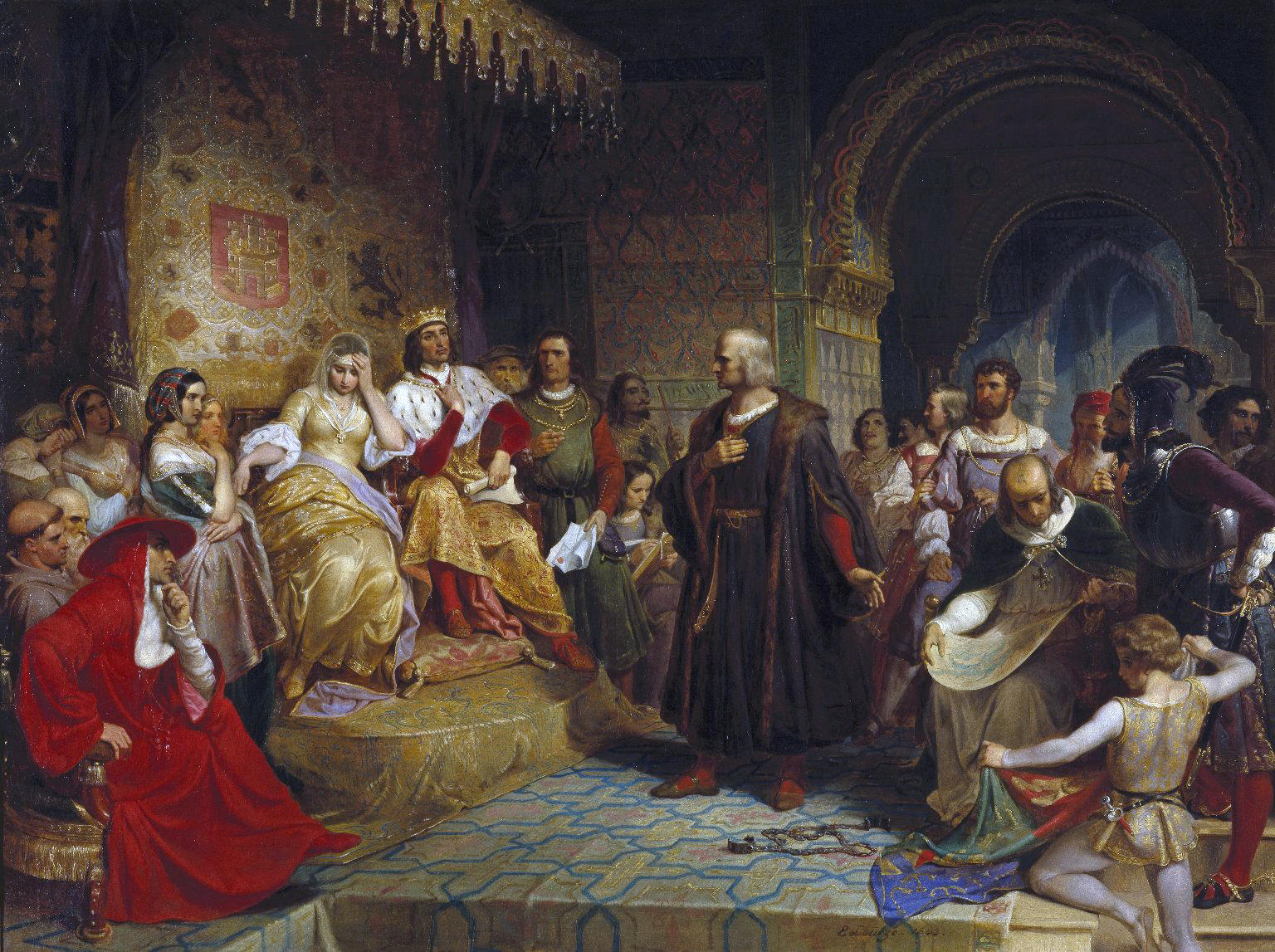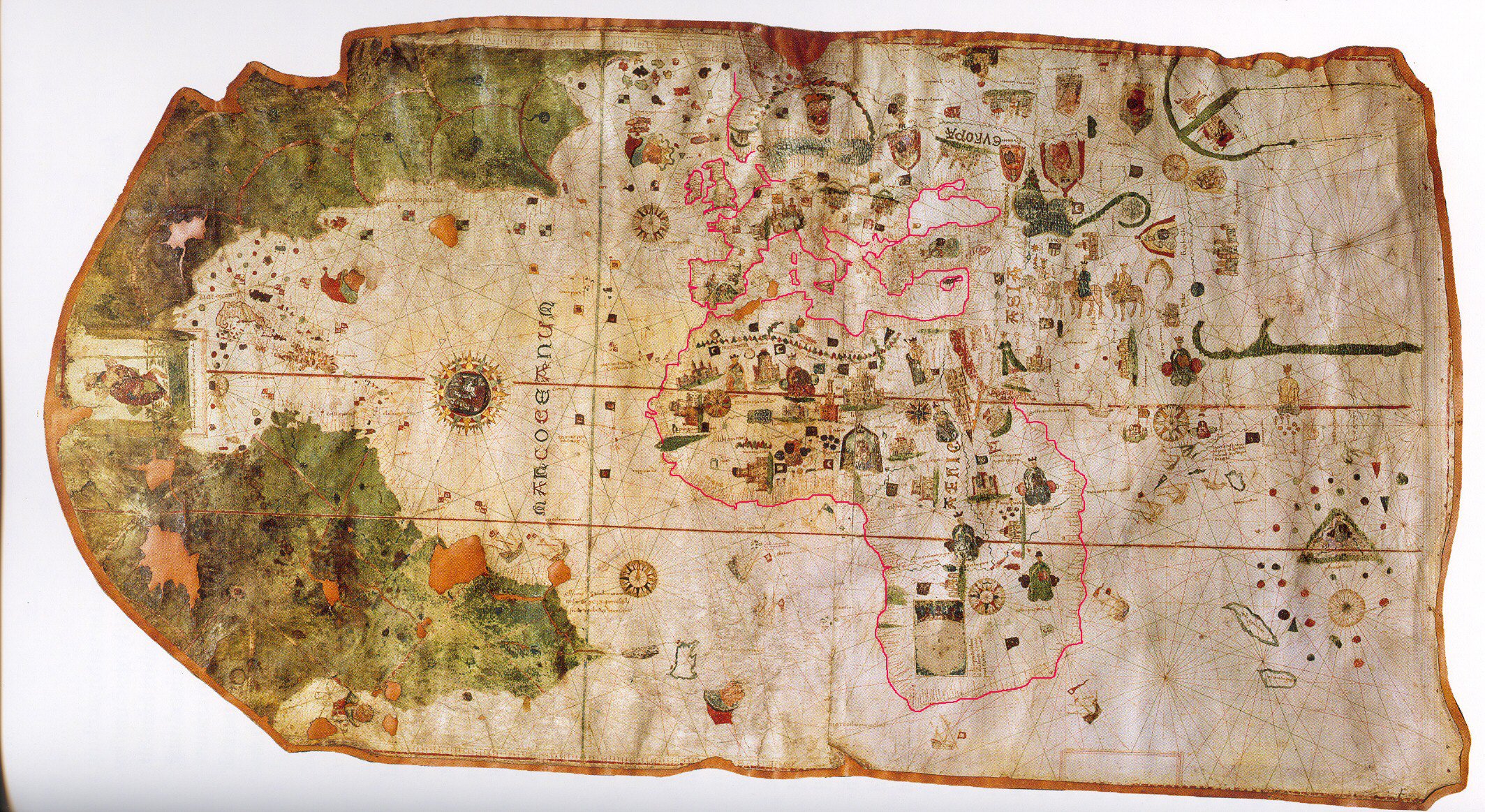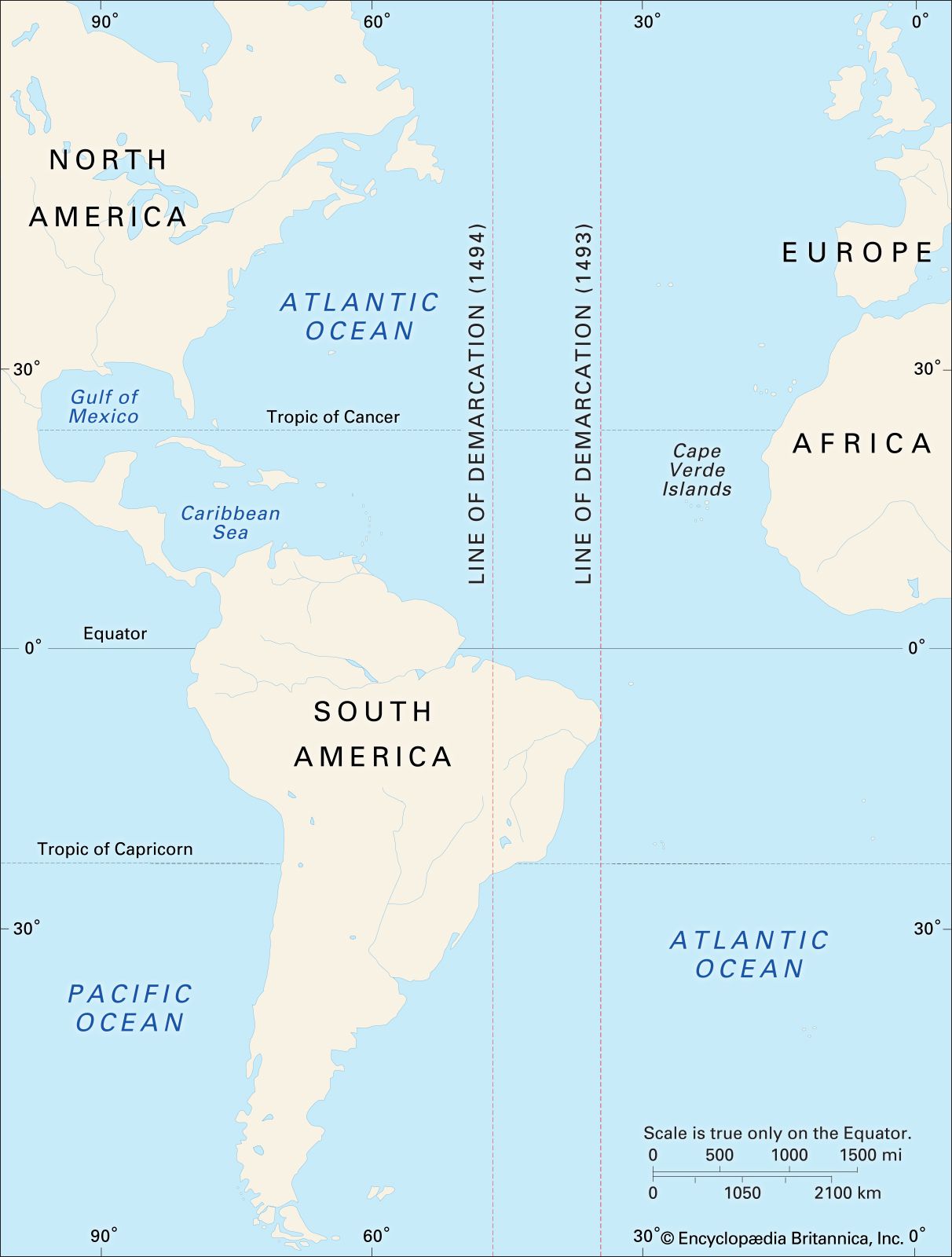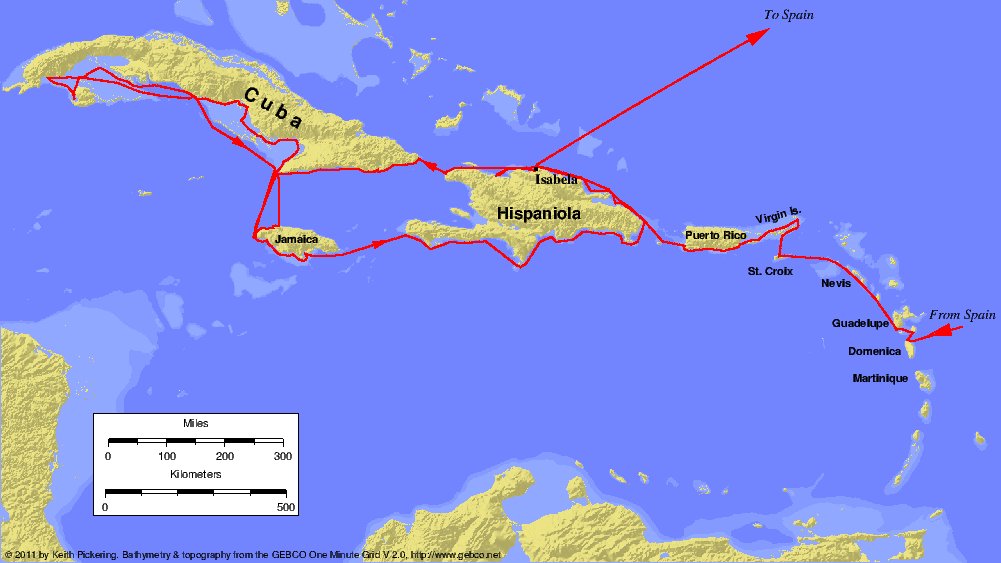Columbus was hailed as a hero when he arrived in Spain after his voyage. King Ferdinand and Queen Isabel were holding court in Barcelona, and he immediately sent them a now famous letter in which he described his discoveries. He began by insisting that he had reached Asia, and gave the location of Hispaniola as being “off the coast of China.” He continued with “Its mountains and hills, plains and pastures, are both fertile and beautiful ... the harbours are unbelievably good and there are many wide rivers of which the majority contain gold”. He rounded off his description with, “Hispaniola is a miracle. ... There are many spices and great mines of gold and other metals”. This letter was reproduced in many languages and distributed to an eager audience across Europe, who focused on the repeated references to the abundance of gold.
He left Seville and followed his letter, taking his retinue across Spain by land to Barcelona. This was a repeat performance of the one he had given to the King of Portugal, and he presented the same captured Taíno natives from Cuba that he had shown King Alfonso.

Columbus before the Queen. Painting by Emanuel Leutze.
Meanwhile, the other half of the expedition had stepped out of the shadows created by the much-changed and edited version of the biography of Columbus that we are left with. Juan de la Cosa returned to Puerto Santa Maria near Cádiz and updated the Mappa Mundi, the world chart. The extreme western end of old chart ended at the Azores, but de la Cosa added a new section, and began drawing in the newly discovered islands. This new chart was freely available to every mariner who cared to visit his office, and there were plenty of visitors.

Mappa Mundi. Wikipidia. Red outline of old world drawn by author.
The old Treaty of Tordesillas was drawn up in 1492 by Pope Alexander VI to prevent unnecessary strife between España and Portugal. He had placed an arbitrary line down the centre of the Atlantic with everything west of that line belonging to Spain, and before Columbus’ discovery, the Portuguese were very pleased with the arrangement; there was nothing west of that line but open ocean. But when Columbus returned and dropped anchor in Lisbon, the King of Portugal interrogated him before he could report to Isabel and Ferdinand. He realised that the treaty robbed him of all the new discoveries, and began lobbying the pope to change the rules. As a second line of defence, he accused Columbus of faking his voyage and said that he had, in fact, sailed south to Africa to claim discoveries there. This was a clear violation of the treaty. Juan de la Cosa’s map was proof that this was a lie.
The pope, realising that Columbus’ discovery was to change the balance of power throughout Europe in España’s favour, issued four bulls which dictated how the new lands were to be divided and colonised. (Three of these bulls are now collectively known as the Bulls of Donation.) The old Inter caetera, treaty issued 4 May 1493was annulled, and the new edict moved the line 370 leagues (930 sea miles) west of the Cape Verde islands. This became known as The 1494 Treaty of Tordesillas, and was ratified during the next decade by Pope Julius II.

New line of division
Isabel and Ferdinand wasted no time in capitalising on their investment. They immediately organised a second expedition, once more to be led by The Admiral of the Ocean. This time they sent two naos (like the Santa Maria) and 15 caravels, one of which was the Niña from the first voyage. Their instructions to Columbus were explicit: he was to encourage friendly relations with the natives with a view to converting them to the Catholic faith. The fleet left the harbour at Cádiz on 25 September 1493 and arrived 36 days later on November 3rd at a group of small islands now known as the Lesser Antilles. They spent the next ten days island-hopping to the north where he saw and named the Virgin Islands, but it was on Santa Cruz that things became serious. During his previous expedition Columbus had been warned by the natives about the Caribs, who were said to be cannibals. He had dismissed this as a tale, but near to Santa Cruz they encountered a canoe containing several Carib men and some captives. The Caribs immediately began firing arrows at them and Columbus returned fire, killing all but two, one of whom he ordered beheaded and the other thrown overboard. Two of the captives had been castrated by the Caribs and the others were women who were kept as sex slaves. They determined that all were to be later eaten. Their next port of call was at present day Puerto Rico, where they rescued a group of 20 women and children who being used as sex slaves, their menfolk having already been killed and eaten.

The second voyage of Columbus. Map: Keith Pickering.
Columbus was now worried about the fate of the men he had left behind at La Navidad, and as they drew near the fort he fired lombards and lit flares hoping for a response. On the morning of 28th November they found the burned out ruins of the fort and the bodies of the men who had elected to stay there. The local chief, Caonabo, had killed them all after two or three of the Spaniards had formed a gang and had gone searching for gold, taking and raping two or three women each and killing several natives.
The small fleet moved on and fought adverse winds for the next 25 days before finally landing on the north coast of Hispaniola and establishing the settlement of La Isabela. From here they explored the region looking for gold and established a small outpost in the interior.
He sailed around to the south side of Cuba, still convinced that this was a part of China, and discovered Jamaica before returning to La Isabela. Columbus’ dream of peacefully converting the natives to Christianity was evaporating before his eyes. After centuries of war defeating the Moors, the lust for gold, looting and power was inbred in the Spaniards who made up the second voyage. The killings at La Navidad and the discovery of cannibalism provided a perfect excuse for the horrors that were to come. Within the crews of Columbus’ new fleet were some battle hardened troops from the Islamic campaign and the following war with Portugal and España. One of these was Alonso de Ojeda who was described by those who knew him as "Always the first to draw blood wherever there was a war or quarrel." He was a trusted agent for Isabel and would go on after Columbus to become an explorer himself and lead several expeditions of conquest.
It’s probable that he knew of Ojeda’s reputation when Columbus sent him to the village of Ciabo where the natives were being used to mine gold. Ojeda immediately arrested several natives and accused them of theft. After cutting off the ears of one of them he set the rest to Columbus in chains. Columbus ordered them all to be beheaded. The die was cast for the enslavement of the natives of the Caribbean. During his reign, Columbus was responsible for the disfigurement dismemberment and execution of Spanish and Taíno alike for minor crimes.
Sometime early in 1494 Columbus appointed one of his military officers, named Margarit, as his second in command with instructions to implement Isabel’s wish to convert the Taíno to the Catholic faith. Margarit was authorised by Columbus to cut off ears and noses if the natives were caught stealing, but his lieutenant exceeded his orders and began beating and raping the natives. During the next two years, none of the Taíno were baptised to the Christian faith and Columbus’ brother, Diego, berated Margarit for his failings. Insulted by the accusations, Margarit sailed back to España with three caravels and Fray Buil, who was supposed to perform the baptisms that Isabel had wanted. In late 1494 they arrived in España and immediately sought audience with the king and queen. They complained to the court that the Columbus brothers were incompetent and corrupt. Meanwhile, Margarit's soldiers who had remained in the islands continued a brutal oppression of the natives, and seemingly, Columbus and his brother were complicit in some of these atrocities. But there was another evil in the blood of the Spanish that nobody suspected, and a corresponding evil in the blood of the Taíno and Caribs which was equally foul.
When the Old World met the New World in 1492, it was not the first time that two biospheres had collided. When the Ice Age was in retreat some 18,000 years earlier, human hunter-gatherers had migrated across the land-bridge of Berengia between Asia and America and expanded south to reach South America some 3,000 years later. The consequences of the influx of people who had immunity to a number of Old World diseases into the, until-then, isolated American fauna was catastrophic. Mastodons and horses in the northern continent and giant sloths on the southern continent all disappeared at the same time that the humans arrived. One theory is that the animals were hunted to extinction, but the other theory is that they were killed by diseases carried by the humans.
Before the end of 1494 two-thirds of the Spanish settlers had died of diseases that their immune systems had never encountered before. Things were equally as bad for the natives. They were exposed to Swine Flu, which hundreds of generations of Europeans had become immune to, but which debilitated the natives so much that they were too ill to work the fields or hunt. Many died of starvation in their beds because their relatives were too weak to care for them. By 1526 the Taíno population of Hispaniola had fallen from an estimated 1492 figure of 500,000 down to 500; but that was not the half of it.
The first recorded case of syphilis in Europe was in 1493, but by 1526 when King Charles VIII of España invaded Naples, his army had been riddled by the Great Pox which was to claim 5 million dead throughout Europe. Though it’s hard to say definitely, Columbus’ voyages are thought to have brought syphilis to Europe.
Things were going from bad to worse for the Taíno. According to a written explanation by Columbus’ son Ferdinand, Columbus had installed a tribute system whereby each native older than 14 years was to deliver “a large hawks’ bell” of gold dust or 25 lbs of cotton. For this they received a brass disc to wear around their necks. Natives who did not have a disc were to receive a light punishment. The light punishment was at the request of Queen Isabel, who had suggested the idea. However, the Spaniards took it upon themselves to cut off the hands of those who had no disc. This was a death sentence for the Indians and many fled or committed suicide.
Many natives rebelled against their Spanish overlords and were captured, and in Febrary 1495 Columbus shipped around 500 natives to España to be sold as slaves, 40% of whom died en-route. Within that same year, Florentine merchant Gianotto Berardi, with the blessing of the crown, assembled a fleet of ships and sailed to Hispaniola where in October he loaded them with alleged prisoners and cannibals and returned to sell them into slavery in Europe. For his enterprise he received nearly 40,000 maravedí.
Within three short and eventful years the paradise that Columbus had discovered had been turned into a hell on earth. But as we know, much worse was to come.